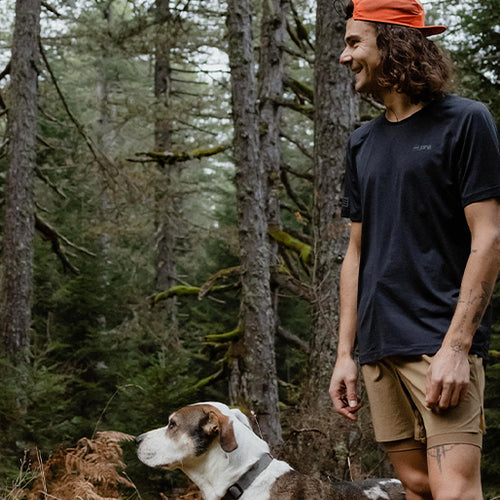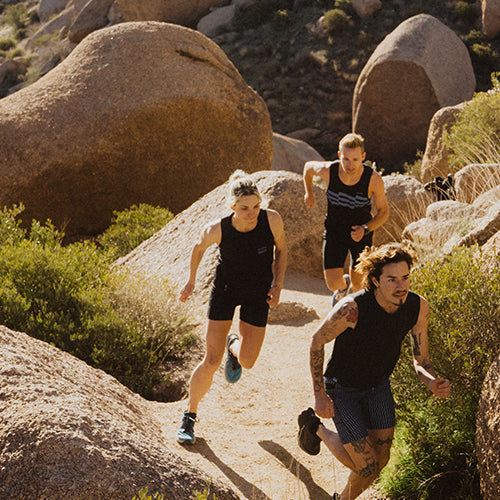DATE
April 14, 2021
WORDS
Brandon Chase and Joe McConaughy
There are an endless amount of routes and trails that could be used for fastpacking trips. Below are some of the most iconic and marvelous options from across the United States...
...with some basic information and a short description of each, as well as links to their pages on FastestKnownTime.com -- a great resource even if you don’t plan to attempt a record-setting effort. These options are great for first-time fastpackers since they are well-marked, highly-trafficked, and logistically simple to manage.

Photo by Brandon Chase.
Location: Maine
Length: 96.5mi
Elevation Gain: 18,416ft
GPX: download
Description: The Hundred Mile Wilderness runs from Monson to Abol Bridge, just south of Mt. Katahdin and the northern terminus of the Appalachian Trail (AT). It’s known as one of the wildest and most remote sections of the entire AT which is made more difficult by the rugged terrain it traverses. The corridor passes by a number of pristine ponds and summits multiple rock-capped mountains while providing ample shelters, campsites, and solitude along the way.

Photo by Salomé Guruli on Unsplash.
Location: White Mountains, New Hampshire
Length: 28.7mi
Elevation Gain: 9,100ft
GPX: download
Description: This rugged and iconic route in the White Mountains has become a popular backpacking destination and hearty one-day challenge for experienced mountain runners. It connects eight “4,000 footers” via the technical and rooty pathway through some of the most picturesque scenery New Hampshire has to offer. Joe ran this route in the winter of 2019 for an added challenge and it did not disappoint!

Photo by Brandon Chase.
3. Appalachian Trail through Massachusetts
Location: Massachusetts
Length: 90mi
Elevation Gain: 20,000ft
GPX: download
Description: The Appalachian Trail runs through the Berkshires of Massachusetts for about 90 miles and traverses Mount Greylock, the state’s highest point at 3,491 feet, as well as other notable landmarks such as Sages Ravine, Benedict Pond, Upper Goose Pond, and Warner Mountain as well as the hiker towns of Dalton and Cheshire. It’s a smooth and well-flowing section of the AT that should not be missed.

Photo by Joshua J. Cotten on Unsplash.
Location: North Carolina & South Carolina
Length: 73.1mi
Elevation Gain: 14,348ft
GPX: download
Description: The Foothills Trail extends 76 miles from Table Rock State Park to Oconee State Park over many mountains and rivers in upstate South Carolina and Western North Carolina. It’s considered one of the most unsung and underrated trails in the Southeast and offers access to a number of spectacular waterfalls along its route. More information available at the trail’s website.

Photo by Andrew Neel on Unsplash.
5. Appalachian Trail through Shenandoah National Park
Location: Virginia
Length: 110mi
Elevation Gain: 31,500ft
GPX: download
Description: This classic section of the Appalachian Trail is bookended by the towns of Front Royal and Waynesboro, VA. The route travels the entire length of Shenandoah National Park’s ridgeline and criss-crosses the Blue Ridge Parkway countless times along the way. The distance and terrain are challenging, but it’s a highly-trafficked corridor and logistically simple to pursue thanks to the abundance of hiker services and shuttles at either terminus.

Photo by Connor Wilkins on Unsplash.
Location: Arkansas
Length: 147.3mi
Elevation Gain: 25,000ft
GPX: download
Description: The Ozark Highlands Trail is a premier long-distance route in northwest Arkansas that is an ideal choice for off-season trips as its peak season is fall through spring. Although still being built, over 200 miles of the trail is fully usable and this particular section runs from Lake Fort Smith to Woodlum over the Boston Mountains through some of the highest, most rugged, and most scenic parts of the Ozarks.

Photo by Omer Nezih Gerek on Unsplash.
7. Grand Canyon Rim-to-Rim-to-Rim (R2R2R)
Location: Arizona
Length: 42.7mi
Elevation Gain: 15,385ft
GPX: download
Description: This world-class route is famous in the ultrarunning world and is one of the most highly-competitive and contested Fastest Known Time speed records. It also makes for a fantastic fastpacking trip as it drops 5,000 feet to the Colorado River, across a bridge, up to the North Rim and back again. Be sure to choose the ideal time of year and get your permits in order to experience this true classic.

Photo by Wesley Gibbs on Unsplash.
Location: California/Nevada
Length: 171mi
Elevation Gain: 31,000ft
GPX: download
Description: As its name suggests, the Tahoe Rim Trail (TRT) circumnavigates Lake Tahoe and passes through both California and Nevada in the process. Because of its circular shape, you can choose any start and end point along the route and experience the serenity of Watson Creek, the Desolation Wilderness, and spectacular views of the Truckee River Canyon. The TRT is open to hiking, mountain biking, and equestrian use in some areas, so you’ll need to share the trail at times.

Photo by John Hanusek on Unsplash.
Location: California
Length: 47.7mi
Elevation Gain: 7,750ft
GPX: download
Description: Beginning at Tuolumne Lodge, this circuitous route visits six of Yosemite’s High Sierra camps for a wonderful hut-to-hut style trip at elevation. Plenty of wonderful views are had along this moderately-difficult journey through one of America’s most iconic National Parks. As with all trips in the Sierra, permits and proper overnight storage of food is necessary and highly regulated.

Photo by David Rupert on Unsplash.
Location: Colorado
Length: 27mi
Elevation Gain: 7,800ft
GPX: download
Description: One of the most spectacular loops in the state, this route circumnavigates the Maroon Bells in the Elk Mountains near Aspen. It is usually a 3-4 night trip for backpackers but can be done in a single go for those up to the challenge. The ideal time to do this route is late July after the snow has melted and flowers are abundant yet there is plenty of water to be found. Also note that this route reaches altitudes greater than 12,000 feet which add an extra layer of difficulty.

Photo by Gibran Hamdan on Unsplash.
Location: Washington
Length: 93mi
Elevation Gain: 24,000ft
GPX: download
Description: This strenuous and scenic route is a Pacific Northwest staple. It encircles Mt. Rainier through lowland forests and into high alpine climates with significant elevation gain and loss. This is a highly-trafficked route and wilderness permits are required, so plan well in advance if you plan to tackle it.

Photo by Dan Meyers on Unsplash.
Location: Oregon
Length: 46.7mi
Elevation Gain: 7,000ft
GPX: download
Description: One of the Oregon High Cascade’s most pristine backpacking destinations, this route weaves between some of the highest peaks in the state and offers jaw-dropping views. Beginning in 2021, permits issued by the Central Cascades Permit System are now required, so advance planning is necessary for this route.
Janji's Fastpacking Packing List
DISCOVER MORE
  |

|




















